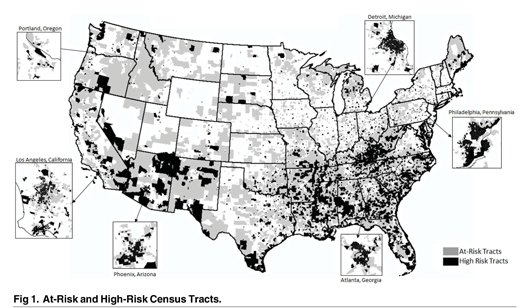The high price to pay for water
By Nisa Islam Muhammad -Staff Writer- | Last updated: Feb 7, 2017 - 9:33:51 PMWhat's your opinion on this article?

|
Think water will always be affordable for all? Think again. Researchers predict that with the rising costs of water bills in the next five years, one third of Americans will not be able to pay their water bill.
The average monthly water bill in America is $120 and if the predictions by researchers at Michigan State University are correct this figure will rise by $49 over the next five years, making water for many households unaffordable.
Some communities already have problems paying their water bills. In the ‘City of Brotherly Love,’ Philadelphia, 40 percent of the city’s 227,000 water bills are past due. The problems were so bad that in 2015 the city council passed legislation for the Philadelphia Water Department to launch a discount program for low-income residents.
Mass shutoffs in Detroit, Mich. resulted in the termination of service for 50,000 households since the start of a campaign in 2014 to shut off water for delinquent residents.
This high cost of water is the subject of a report released in January, ‘A Burgeoning Crisis? A Nationwide Assessment of the Geography of Water Affordability in the United States’ by Elizabeth Mack and Sarah Wase.
The report found that skyrocketing water costs could be found in Atlanta and Seattle, Washington which have some of the highest water rates in the country at $325.52 and $309.72 per month for a family of four, respectively.
These rates are based on 100 gallons of water per person per day including, water, sewer, and storm water for 5/8 inch meters. These rates will probably rise as the cost of providing water increases. Why is the cost rising?
“A variety of pressures ranging from climate change, to sanitation and water quality, to infrastructure upgrades, are placing increasing strain on water prices. Estimates of the cost to replace aging infrastructure in the United States alone project over $1 trillion are needed in the next 25 years to replace systems built circa World War II, which could triple the cost of household water bills,” explained the authors in the report’s introduction.
“Other studies estimate that adaptations to water systems to deal with climate change will cost the United States more than $36 billion by 2050 [10]. For example, an increasing number and intensity of weather events call for improvements to waste-water facilities to manage storm water.”
According to Circle of Blue, an organization consisting of scientists and journalists that monitor and provide information about the world’s water resources, besides revenue needed to address infrastructure problems, decline in overall water usage, ensuring rates are affordable for society’s most vulnerable and enacting accountability measures for those who waste water also adds to the problem of costs.
“Balancing the three forces is always a difficult task. More conservation can dent revenue, for instance, and the need for more revenue can upend affordability. These conflicting trends exerted greater pressure on utilities last year than ever before,” notes circleofblue.org.
Political scientist, Dr. Wilmer Leon sees privatization as part of the problem also. “The problems in Flint with their water crisis is just the tip of the iceberg. One of the problems is privatization. Nestle (largest water company in the country) has permits to pump gallons and gallons of water from Lake Michigan, free of charge and then sell it to the residents of Flint. All the while the residents of Flint are paying a water bill for poisoned water,” he told The Final Call.
“When you look at the overall mindset of privatization for charter schools, rumors the (Office of) Veteran Affairs being privatized, the whole process of privatizing what used to be public services will not surprise me as it relates to the water supply. Especially when you look at the reverse trend of flight from the suburbs to the cities.”
He pointed out the example of Washington, D.C. where new condos are going up all over the city. Single family homes are being replaced with condos increasing the number of people per square feet. The amount of water needed to service these increasing numbers of people is exponential.
“Unless the government spends necessary money to upgrade the infrastructure, we will reach a breaking point. The infrastructure can’t support the increasing numbers of people. Just like there are new tolls roads they will say we need to contract private companies to handle this and the rates will go up,” Dr. Leon said.
According to the report, affordability is not only an issue for customers in the United States but for utility customers around the globe. This is the case for low-income households who must use a disproportionate share of income to pay for water services.
An affordability study in France highlights that single parent families, particularly female-headed households, and large households receiving social assistance are most at risk for affordability issues. In many countries, water is also not priced at full cost recovery levels, which means that this affordability challenge is likely to worsen in the near future. (Final Call staff contributed to this report.)
INSIDE STORIES AND REVIEWS
-
-
About Harriett ... and the Negro Hollywood Road Show
By Rabiah Muhammad, Guest Columnist » Full Story -
Skepticism greets Jay-Z, NFL talk of inspiring change
By Bryan 18X Crawford and Richard B. Muhammad The Final Call Newspaper @TheFinalCall » Full Story -
The painful problem of Black girls and suicide
By Charlene Muhammad -National Correspondent- » Full Story -
Exploitation of Innocence - Report: Perceptions, policies hurting Black girls
By Charlene Muhammad -National Correspondent- » Full Story -
Big Ballin: Big ideas fuel a father’s Big Baller Brand and brash business sense
By Bryan Crawford -Contributing Writer- » Full Story






 Click Here Stay Connected!
Click Here Stay Connected!








